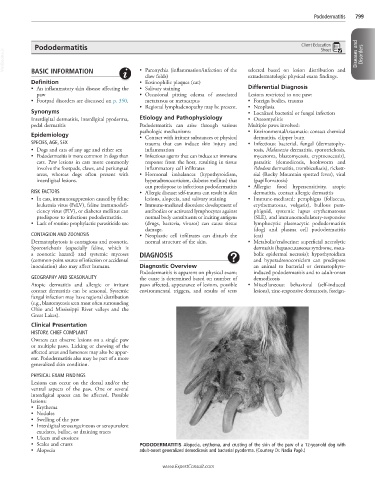Page 1590 - Cote clinical veterinary advisor dogs and cats 4th
P. 1590
Pododermatitis 799
Pododermatitis Client Education
Sheet
VetBooks.ir Diseases and Disorders
• Paronychia (inflammation/infection of the
BASIC INFORMATION
extradermatologic physical exam findings.
claw folds) selected based on lesion distribution and
Definition • Eosinophilic plaques (cat)
• An inflammatory skin disease affecting the • Salivary staining Differential Diagnosis
paw • Occasional pitting edema of associated Lesions restricted to one paw:
• Footpad disorders are discussed on p. 350. metatarsus or metacarpus • Foreign bodies, trauma
• Regional lymphadenopathy may be present. • Neoplasia
Synonyms • Localized bacterial or fungal infection
Interdigital dermatitis, interdigital pyoderma, Etiology and Pathophysiology • Osteomyelitis
pedal dermatitis Pododermatitis can arise through various Multiple paws involved:
pathologic mechanisms: • Environmental/traumatic: contact chemical
Epidemiology • Contact with irritant substances or physical dermatitis, clipper burn
SPECIES, AGE, SEX trauma that can induce skin injury and • Infectious: bacterial, fungal (dermatophy-
• Dogs and cats of any age and either sex inflammation tosis, Malassezia dermatitis, sporotrichosis,
• Pododermatitis is more common in dogs than • Infectious agents that can induce an immune mycetoma, blastomycosis, cryptococcosis),
cats. Paw lesions in cats more commonly response from the host, resulting in tissue parasitic (demodicosis, hookworm and
involve the footpads, claws, and periungual inflammatory cell infiltrates Pelodera dermatitis, trombiculiasis), rickett-
areas, whereas dogs often present with • Hormonal imbalances (hypothyroidism, sial (Rocky Mountain spotted fever), viral
interdigital lesions. hyperadrenocorticism, diabetes mellitus) that (papillomatosis)
can predispose to infectious pododermatitis • Allergic: food hypersensitivity, atopic
RISK FACTORS • Allergic disease: self-trauma can result in skin dermatitis, contact allergic dermatitis
• In cats, immunosuppression caused by feline lesions, alopecia, and salivary staining • Immune-mediated: pemphigus (foliaceus,
leukemia virus (FeLV), feline immunodefi- • Immune-mediated disorders: development of erythematosus, vulgaris), bullous pem-
ciency virus (FIV), or diabetes mellitus can antibodies or activated lymphocytes against phigoid, systemic lupus erythematosus
predispose to infectious pododermatitis. normal body constituents or inciting antigens (SLE), and immunomodulatory-responsive
• Lack of routine prophylactic parasiticide use (drugs, bacteria, viruses) can cause tissue lymphocytic plasmacytic pododermatitis
damage. (dog) and plasma cell pododermatitis
CONTAGION AND ZOONOSIS • Neoplastic cell infiltrates can disturb the (cat)
Dermatophytosis is contagious and zoonotic. normal structure of the skin. • Metabolic/endocrine: superficial necrolytic
Sporotrichosis (especially feline, which is dermatitis (hepatocutaneous syndrome, meta-
a zoonotic hazard) and systemic mycoses DIAGNOSIS bolic epidermal necrosis); hypothyroidism
(common-point source of infection or accidental and hyperadrenocorticism can predispose
inoculation) also may affect humans. Diagnostic Overview an animal to bacterial or dermatophyte-
Pododermatitis is apparent on physical exam; induced pododermatitis and to adult-onset
GEOGRAPHY AND SEASONALITY the cause is determined based on number of demodicosis
Atopic dermatitis and allergic or irritant paws affected, appearance of lesions, possible • Miscellaneous: behavioral (self-induced
contact dermatitis can be seasonal. Systemic environmental triggers, and results of tests lesions), zinc-responsive dermatosis, foreign-
fungal infection may have regional distribution
(e.g., blastomycosis seen most often surrounding
Ohio and Mississippi River valleys and the
Great Lakes).
Clinical Presentation
HISTORY, CHIEF COMPLAINT
Owners can observe lesions on a single paw
or multiple paws. Licking or chewing of the
affected areas and lameness may also be appar-
ent. Pododermatitis also may be part of a more
generalized skin condition.
PHYSICAL EXAM FINDINGS
Lesions can occur on the dorsal and/or the
ventral aspects of the paw. One or several
interdigital spaces can be affected. Possible
lesions:
• Erythema
• Nodules
• Swelling of the paw
• Interdigital serosanguineous or seropurulent
exudates, bullae, or draining tracts
• Ulcers and erosions
• Scales and crusts PODODERMATITIS Alopecia, erythema, and crusting of the skin of the paw of a 12-year-old dog with
• Alopecia adult-onset generalized demodicosis and bacterial pyoderma. (Courtesy Dr. Nadia Pagé.)
www.ExpertConsult.com

